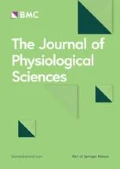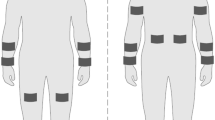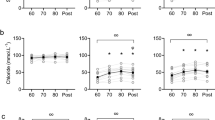Abstract
The purpose of this study was to determine the effect of increases in exercise intensity on the sweat lactate concentration and lactate excretion rate. Eight healthy male volunteers complete a 90-min exercise bout of treadmill walking in a 35°C and 40% relative humidity environmental chamber. During the exercise trial, the subjects performed three 30-min ordered exercise bouts at 60, 70, and 80% of their age-predicted maximum heart rate (HRmax), with 10 min of rest outside the chamber between bouts. Sweat rate was measured volumetrically during each of the three exercise bouts on the flexor surface of the proximal half of the right forearm. Sweat lactate concentration ([lactate]sweat) was measured in each sample and multiplied by the forearm sweat rate to calculate the lactate excretion rate (LER). There was a significant (P < 0.05) decrease in the [lactate]sweat at the 70 and 80% HRmax exercise intensities compared to the 60% HRmax exercise intensity. Conversely, the LER increased significantly at the highest two exercise intensities compared to the 60% HRmax exercise intensity. Such data suggest that increases in exercise intensity require an increase in lactate production, as measured by the LER. Furthermore, the decreased [lactate]sweat at the higher exercise intensities is most likely the result of increased sweat production causing a dilution effect on the [lactate]sweat, thus limiting its ability to accurately indicate the metabolic activity of the sweat gland.
Similar content being viewed by others
Introduction
High concentrations of lactate in human sweat were noted in the scientific literature over 50 years ago [1–3]. Since that time it has been shown that the sweat lactate concentration ([lactate]sweat) is independent of the blood lactate concentration [4–7] and is the result of the glycolytic breakdown of blood glucose and glycogen in the sweat gland [5, 7, 8]. Thus, [lactate]sweat should theoretically reflect glycolytic ATP production supporting sweat formation and secretion in eccrine glands [7, 9, 10]. Interestingly, however, numerous studies [1, 4, 9–12] have reported an inverse relationship between [lactate]sweat and exercise intensity. The inverse relationship is most likely the result of increased sweat production causing a dilution effect on the [lactate]sweat [11, 13–15], thus limiting its ability to accurately indicate the metabolic activity of the sweat gland.
More recently, Falk et al. [9] suggested that the lactate excretion rate (LER) is a better indicator than the [lactate]sweat of the sweat gland glycolytic rate. Supporting this, they found that the LER was significantly correlated with sweat rate (r = 0.57). However, to calculate LER they measured the [lactate]sweat from the lower back and multiplied it by whole-body sweat rate. This assumes that the [lactate]sweat is uniform for the entire body. Such an assumption, however, is invalid as Patterson et al. [16] have recently shown a large variability in the [lactate]sweat when comparing 11 different body sites.
In light of the above, the purpose of the current study was to determine the effect of exercise intensity on the [lactate]sweat and the LER. It was hypothesized that increases in exercise intensity would result in an increase in the LER while [lactate]sweat simultaneously decreased.
Methods
Eight healthy male subjects volunteered for the study. They had a mean (±SD) age, height, and weight of 29.8 ± 6 years, 178 ± 10 cm, and 88.50 ± 32.67 kg, respectively. The San Diego State University Institutional Review Board approved the study, and written informed consent was acquired from all subjects prior to participation. All subjects also completed a physical activity recall questionnaire (PAR-Q).
Subjects reported to the laboratory well-hydrated as determined by having a urine specific gravity of 1.020 or less and having refrained from vigorous exercise for at least 3 h. They were required to complete a 90-min exercise bout of treadmill walking in a 35°C and 40% relative humidity environmental chamber. During the exercise trial, the subjects performed three 30-min ordered exercise bouts at 60, 70, and 80% of their age-predicted maximum heart rate, with 10 min of seated rest outside the chamber between bouts. Pilot data revealed that the lowest exercise intensity (60% HRmax) was needed to produce enough forearm sweat for [lactate]sweat analysis, whereas the highest exercise intensity (80% HRmax) was the maximum that all subjects could complete. The three exercise bouts were ordered by exercise intensity from easiest to hardest to prevent residual effects from one bout influencing the data collected from a subsequent bout. Specifically, core temperature and sweat rate after intense exercise in the heat are known to remain elevated for several hours. Thus, if an 80% HRmax bout of exercise immediately preceded a 60% HRmax bout, it was felt that residual effects could have existed that might have affected the data. The treadmill speed and grade were individually adjusted to achieve the desired heart rates. Subjects were required to drink 500 ml of water during each of the three exercise bouts, and additional water was allowed ad libitum during the recovery periods. Urinary specific gravity was measured again immediately following the third exercise bout. In addition, dry body weight was measured before the first exercise bout and immediately following the last exercise bout to the nearest 0.01 kg on a balance beam scale.
Heart rate was measured at rest and at min 10 and min 30 of each exercise bout using a trans-sternal Polar heart rate monitor (Polar Elecro Oy, Kempele, Finland). Sweat rate was measured volumetrically during each of the three exercise bouts using a 5 cm2 sweat collector (Macroduct, Wescor, Logan, UT, USA) strapped to the flexor surface of the proximal half of the right forearm. The forearm placement was chosen as it prevented leakage and contamination of the sweat sample while allowing for free arm movement during the treadmill exercise. The skin was marked to ensure that the same location was used for all three exercise bouts. Application of the Macroduct occurred at min 10 of each exercise bout following a careful cleaning of the site with alcohol and distilled water. Additionally, the site was blotted dry with a KimWipe prior to securing the Macroduct collector.
Sweat samples were collected from min 10 to 30 of each of the three exercise bouts. This protocol allowed for sweating to occur prior to the initiation of each collection period. The collected sweat samples were rapidly dispensed into test tubes and stored frozen for lactate analysis at the conclusion of the study. Sweat lactate concentration was measured using a calibrated Y.S.I. lactate analyzer (model 1500, Yellow Springs, OH, USA). Forearm sweat rate was expressed in milligrams per square centimeter per minute (mg cm−2 min−1), and [lactate]sweat was expressed in millimoles per liter (mmol l−1). Lactate excretion rate (LER), in nanomoles per square centimeter per minute (nmol cm−2 min−1), was calculated as the product of forearm sweat rate times [lactate]sweat.
Repeated measure ANOVAs were used to compare the mean forearm sweat rate, [lactate]sweat, and LER data obtained from the three different exercise bouts. Significance was set at the P < 0.05 level. Pearson product moment correlations were calculated for the [lactate]sweat versus sweat rate and LER versus sweat rate relationships.
Results
The mean (±SD) urine specific gravity and body weight before the start of the first exercise bout were 1.008 ± 0.006 and 88.50 ± 32.67 kg, respectively. Immediately following the last exercise bout the values were 1.008 ± 0.006 and 88.13 ± 32.63 kg, respectively. Such results strongly suggest that the fluid ingestion schedule used in the current study prevented dehydration from occurring during exercise in the subjects.
The mean resting heart rate prior to the start of the three exercise bouts was 75 ± 20, 82 ± 22, and 81 ± 19 bpm, respectively. The mean heart rate for the three exercise bouts recorded at 10 min of exercise was 107 ± 7, 127 ± 10, and 142 ± 15 bpm, respectively. The mean HR at the end of each exercise bout was 114 ± 4, 135 ± 6, and 157 ± 6 bpm, respectively. The mean (±SD) forearm sweat rate data for the three exercise bouts are presented in Fig. 1. The rates were 0.49 ± 0.21, 0.92 ± 0.31, and 1.04 ± 0.34 mg cm−2 min−1 for the 60, 70, and 80% intensity exercise bouts, respectively. The mean values obtained during the 70 and 80% exercise bouts were significantly greater than the 60% value. Figure 2 shows the mean [lactate]sweat obtained during the three exercise bouts. During the 60% intensity exercise bout the mean value was 14.6 ± 1.5 mmol l−1. It decreased significantly to 11.7 ± 1.4 and 11.6 ± 1.4 mmol l−1 during the two higher intensity exercise bouts. The mean LER data are presented in Fig. 3. As can be seen, the LER was 7.3 ± 3.0 nmol cm−2 min−1 during the lowest intensity exercise bout, and increased significantly to 10.8 ± 4.1 and 11.9 ± 4.4 nmol cm−2 min−1 during the 70 and 80% intensity exercise bouts, respectively.
The [lactate]sweat versus sweat rate relationship is shown in Fig. 4. As can be seen there was a significant (P < 0.05) inverse linear relationship for the two variables with a correlation coefficient of r = −0.48. At low sweat rates, the mean [lactate]sweat was approximately 15 mmol l−1 and fell to about 11 mmol l−1 at the highest sweat rates. The LER versus sweat rate relationship is presented in Fig. 5. There was a significant positive linear correlation between the two variables (r = 0.94).
Discussion
The formation of sweat in the human eccrine gland is the result of a two-step process. The first step involves the secretion of an isosmotic precursor sweat by the proximal secretory coil. Next sodium and chloride ions are reabsorbed from the precursor sweat during its passage along the distal duct segment of the gland [17–19]. Both of these steps are energy dependent and driven by the ouabain-sensitive Na+- K+ ATPase located in the basolateral membrane of both the secretory coil and the distal reabsorption duct [20]. This is supported by the fact that ouabain blocks sweat secretion and sodium reabsorption [8, 21].
It has been previously shown that blood glucose is the major substrate for energy production by the human eccrine sweat gland [5, 7, 8]. This is evidenced by the fact that in single isolated sweat glands, in vitro, removal of glucose from the incubation medium rapidly abolishes sweat secretion [19]. In isolated human forearm sweat glands, the metabolism of glucose appears to consist equally of both oxidative phosphorylation in the abundant mitochondria located in the clear cells of the secretory coil and substrate-level phosphorylation via glycolysis [18, 19, 22]. This was demonstrated by a large increase in both lactate and carbon dioxide production following cholinergic stimulation of isolated sweat glands using the cholinergic agonist, mecholyl.
Thus, from the in vitro data collected on isolated sweat glands [18, 19, 22], it could be hypothesized that the [lactate]sweat should increase with increases in exercise intensity and/or sweat rate. However, numerous studies [1, 4, 9–12] have shown the exact opposite. For example, Falk et al. [9] reported a correlation of r = −0.57 between sweat rate and [lactate]sweat in 36 boys exercising in the heat. More recently, Patterson et al. [16] found a correlation of r = −0.53 between sweat rate and [lactate]sweat collected from 11 different sites on the body during exercise-induced thermal sweating. Such data agree quite favorably with the r = −0.48 correlation between sweat rate and [lactate]sweat found in the current study (Fig. 4). Furthermore, Fig. 2 shows that a significant decrease in [lactate]sweat occurred at the 70 and 80% HRmax workloads compared to the 60% HRmax. However, as discussed previously, from a metabolic point of view, an inverse relationship between [lactate]sweat and sweat rate seems illogical. Most investigators [11, 13–15] believe that the inverse relationship is the result of high sweat rates diluting the [lactate]sweat, thus limiting its usefulness as a marker of the glycolytic activity in the sweat gland.
As can be seen in Fig. 1 significant increases in forearm sweat rate occurred in the current study at the two highest intensity workloads compared to the lowest intensity exercise bout. However, there was no significant difference in the forearm sweat rate obtained between the 70 and 80% HRmax workloads. We hypothesize that this was the result of exercise-induced hyperosmolality which has previously been shown to reduce thermoregulatory sweating [23]. Interestingly, both the LER and [lactate]sweat followed similar treads of not showing significant differences between the 70 and 80% HRmax workloads. Such data support the dilutional hypothesis suggested by others [11, 13–15].
As seen in Fig. 3, the most important finding of the current study is that LER was significantly higher at the 70 and 80% HRmax exercise intensities compared to the 60% HRmax workload. Such data suggest that the metabolic demands of the increased sweat production associated with higher intensity exercise require an increase in the glycolytic rate to support ATP resynthesis in the human sweat gland. Interestingly, both the sweat rate and LER were not different between the 70 and 80% HRmax exercise intensities. Such data, in conjunction with the high correlation found between sweat rate and LER presented in Fig. 5, suggest that increases in sweat production, not exercise intensity, are directly responsible for the changes seen in LER. However, the data in Fig. 5 need to be viewed with caution since sweat rate was part of both variables.
Several in vitro studies [8, 22] on isolated monkey and human eccrine sweat glands have previously shown that stimulation with cholinergic agonists causes a significant increase in lactate production. For example, Sato and Dobson [22] reported an increase in lactate production in excised human sweat glands following stimulation with mecholyl. Such data agree with the results of the current study (Fig. 3), which found that the mean LER increased from approximately 7 nmol cm−2 min−1 at the lowest exercise intensity to almost 12 nmol cm−2 min−1 at the highest exercise intensity, or a 1.7-fold increase. Such findings strongly suggest that increases in exercise-induced sweating in vivo require an increase in the glycolytic breakdown of glucose to support ATP resynthesis in the human sweat gland.
In conclusion, the results of the current study show that the LER increased significantly at the highest two exercise intensities compared to the 60% HRmax exercise intensity. Such data suggest that increases in exercise intensity require an increase in lactate production, as measured by the LER, although the relationship was not linear. Furthermore, the decreased [lactate]sweat at the higher exercise intensities is most likely the result of increased sweat production causing a dilution effect on the [lactate]sweat, thus limiting its ability to accurately indicate the metabolic activity of the sweat gland.
References
Astrand I (1963) Lactate content in sweat. Acta Physiol Scand 58:359–367
Robinson S, Robinson AH (1954) Chemical composition of sweat. Physiol Rev 34:202–220
Weiner JS, van Heyningen RE (1952) Observations on lactate content of sweat. J Appl Physiol 4:734–744
Fellmann N, Grizard G, Coudert J (1983) Human frontal sweat rate and lactate concentration during heat exposure and exercise. J Appl Physiol 54:355–360
Gordon RS, Thompson RH, Muenzer J, Thrasher D (1971) Sweat lactate in man is derived from blood glucose. J Appl Physiol 31:713–716
Green JM, Bishop PA, Muir IH, Lomax RG (2000) Gender differences in sweat lactate. Eur J Appl Physiol 82:230–235
Wolfe S, Cage G, Epstein M, Tice L, Miller H, Gordon RS (1970) Metabolic studies of isolated human eccrine sweat glands. J Clin Invest 49:1880–1884
Sato K, Dobson RL (1971) Glucose metabolism of the isolated eccrine sweat gland. I. The effects of mecholyl, epinephrine and ouabain. J Invest Dermatol 56:272–280
Falk B, Bar-Or O, MacDougall JD, McGillis L, Calvert R, Meyer F (1991) Sweat lactate in exercising children and adolescents of varying physical maturity. J Appl Physiol 71:1735–1740
Fellmann N, Labbe A, Gachon AM, Coudert J (1985) Thermal sweat lactate in cystic fibrosis and in normal children. Eur J Appl Physiol 54:511–516
Lamont LS (1987) Sweat lactate secretion during exercise in relation to women’s aerobic capacity. J Appl Physiol 62:194–198
Meyer F, Laitano O, Bar-Or O, McDougall D, Heigenhauser GJF (2007) Effect of age and gender on sweat lactate and ammonia concentrations during exercise in the heat. Braz J Med Biol Res 40:135–143
Green JM, Bishop PA, Muir IH, McLester JR, Heath HE (2000) Effects of high and low blood lactate concentrations on sweat lactate response. Int J Sports Med 21:556–560
Green JM, Pritchett RC, Crews TR, McLester JR, Tucker DC (2004) Sweat lactate response between males with high and low aerobic fitness. Eur J Appl Physiol 91:1–6
Green JM, Pritchett RC, Tucker DC, Crews TR, McLester JR (2004) Sweat lactate response during cycling at 30 degrees C and 18 degrees C WBGT. J Sports Med 22:321–327
Patterson MJ, Galloway SDR, Nimmo MA (2000) Variations in regional sweat composition in normal human males. Exp Physiol 85:869–875
Hubbard JL, Weiner JS (1969) Effect of hyperbaric oxygen on human sweat with particular reference to lactate content. J Appl Physiol 27:715–720
Quinton PM (1983) Sweating and its disorders. Annu Rev Med 34:429–452
Sato K (1977) The physiology, pharmacology and biochemistry of the eccrine sweat gland. Rev Physiol Biochem Pharmacol 79:52–131
Quinton PM, Tormey J (1976) Localization of Na/K–ATPase sites in the secretory and reabsorptive epithelia of perfused eccrine sweat glands: a question to the role of the enzyme in secretion. J Membr Biol 29:383–399
Quinton PM (1981) Effects of some ion transport inhibitors on secretion and reabsorption in intact and perfused single human sweat glands. Pfluegers Arch 391:309–313
Sato K, Dobson RL (1973) Glucose metabolism of the isolated eccrine sweat gland. II. The relationship between glucose metabolism and sodium transport. J Clin Invest 52:2166–2174
Fortney SM, Wegner CB, Bove JR, Nadel ER (1984) Effect of hyperosmolality on control of blood flow and sweating. J Appl Physiol 57:1688–1695
Author information
Authors and Affiliations
Corresponding author
About this article
Cite this article
Buono, M.J., Lee, N.V.L. & Miller, P.W. The relationship between exercise intensity and the sweat lactate excretion rate. J Physiol Sci 60, 103–107 (2010). https://doi.org/10.1007/s12576-009-0073-3
Received:
Accepted:
Published:
Issue Date:
DOI: https://doi.org/10.1007/s12576-009-0073-3









